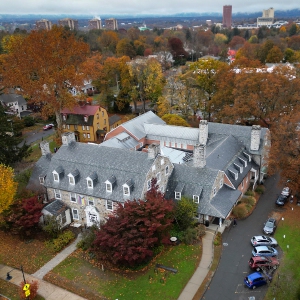Darcy Dumont: My net-zero energy ‘ranchrofit,’ Part 1
| Published: 02-15-2024 8:20 PM |
I’ve been thinking of doing an overall “ranchrofit” on my home for quite a few years now to make it a net-zero energy home, but my general indecisiveness has been holding me up.
I live in Orchard Valley in Amherst, a 1960s planned development where three of the four original models of homes are ranch style. They were intended at the time to be “starter” homes, but, instead turned into “lifetime” homes because many of the original or early owners stayed, often modifying or adding a room or two to their homes to accommodate growing families.
I bought my home in 1997 for $119,000 and it is now valued on Zillow at about $350,000. Meanwhile, I’ve done almost nothing to update it compared to my neighbors, but now my siding, roof and windows need replacement. I already have a main heat pump for heat and a solar array.
I’m in the best place for an “opportunistic” retrofit since I need to do the work one way or another. One of my problems is that most of the products commonly used are, in my opinion, not sustainable. Asphalt roofing, vinyl and cement board siding, vinyl replacement windows and trex-type decking are some examples.
I’d like to figure out how to use more sustainable materials without spending a huge amount of money. Spending more than the house is worth doesn’t make sense if it doesn’t encourage anyone else to do the same.
There are net-zero energy design/builders in the Valley and advisers available to help. I have already availed myself of consultation with the Abode Energy Management team. Locally, Powerhouse Energy Consulting also has a great reputation for good work. Quite a few books have been written about how to create a net-zero energy home through replacing your insulation and adding an airtight “envelope,” replacing fossil fuel heating with electric heat pumps, replacing fossil fuel hot water heaters with heat pump hot water heaters, replacing old, leaky windows with triple-glazed windows, and adding solar panels if you have good access to the sun.
Replacing your roof with a metal roof and replacing your siding with sustainable siding takes it to the next level, but if they’re done when you need to replace them anyway, it makes sense. I’m not an expert but have learned a lot in the process of researching “ranchrofits.” Let’s take a look at each of the elements.
Massachusetts is somewhat unique in providing a free home energy assessment through MassSave. Accredited contractors can conduct a “blower door test” to determine how much air is entering or escaping from your home before the retrofit. Then, conducting a test after the retrofit can help determine the size of the HVAC system and number of solar panels needed to heat and electrify the home.
Article continues after...
Yesterday's Most Read Articles
 Granby Bow and Gun Club says stray bullets that hit homes in Belchertown did not come from its range
Granby Bow and Gun Club says stray bullets that hit homes in Belchertown did not come from its range
 ‘Home away from home’: North Amherst Library officially dedicated, as anonymous donor of $1.7M revealed
‘Home away from home’: North Amherst Library officially dedicated, as anonymous donor of $1.7M revealed
 Super defers Amherst middle school principal pick to successor; one finalist says decision is retaliation for lawsuit
Super defers Amherst middle school principal pick to successor; one finalist says decision is retaliation for lawsuit
 Back to the screen: Amherst authors’ popular ‘Spiderwick Chronicles’ gets a new streaming adaptation
Back to the screen: Amherst authors’ popular ‘Spiderwick Chronicles’ gets a new streaming adaptation
 Annette Pfannebecker: Vote yes for Shores Ness and for Deerfield
Annette Pfannebecker: Vote yes for Shores Ness and for Deerfield
 Sole over-budget bid could doom Jones Library expansion project
Sole over-budget bid could doom Jones Library expansion project
If you are putting on new siding anyway, that’s a great time to take a look at the wall cavity and what has happened to your former insulation over the years. You can take out the old and fill it with loose fill or dense packed cellulose. Then comes the sheathing. A relatively new option is to add a “Zip System,” which is a variation of plywood with insulation added in different depths depending on your climate zone. The Zip System boards completely cover the house, taped at the seams.
Most older homes have double-glazed windows. Mine are reasonably tight but have gotten foggy and are not easy to clean. Double-pane windows have an R-value ranging from 3 to 3.8, while triple-pane windows have an R-value of up to 7- 8, making them more effective at blocking heat flow.
Replacing double-pane units with triple-pane windows reduces energy use and heating costs. My choice for sustainable window materials is wood with aluminum cladding on the exterior rather than vinyl windows.
Next month, I will regale you with the plans of this Amherst resident to use more heat pump heating and AC, a heat pump hot water heater, and to upgrade my siding and roof to be more sustainable. Both the Local Energy Advocates and Amherst Energy and Climate Action Committee maintain a library of webinar recordings that include how to make your home more energy efficient or even net-zero energy.
Darcy DuMont is a former town councilor and sponsor of the legislation creating the Amherst Energy and Climate Action Committee. She is a founding member of Zero Waste Amherst, Local Energy Advocates of Western MA, and the Amherst Climate Justice Alliance and a non-voting member of Valley Green Energy Working Group. She can be contacted at dumint140@gmail.com.

 Guest columnist Rudy Perkins: Dangerous resolution pins ‘aggression’ on Iran
Guest columnist Rudy Perkins: Dangerous resolution pins ‘aggression’ on Iran Richard S. Bogartz: What the ghosts of Warsaw Ghetto know
Richard S. Bogartz: What the ghosts of Warsaw Ghetto know Guest columnist Dr. David Gottsegen: Age issue not so key as question of marbles
Guest columnist Dr. David Gottsegen: Age issue not so key as question of marbles Guest columnist Martha Hanner: Spirit of philanthropy can uplift so many others
Guest columnist Martha Hanner: Spirit of philanthropy can uplift so many others